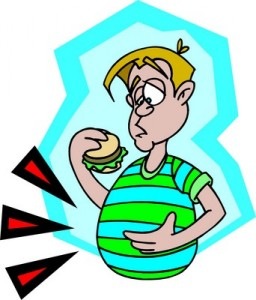 Have you ever had a day when it seems like all you do is eat and eat and eat some more? You eat everything – a bagel for breakfast, a donut for a midmorning snack, and at lunch with friends or coworkers and before you know it the breadbasket is empty. You might follow it up by some coffee and a snack in the afternoon. Maybe it’s a workday and you amble down to the hall to the vending machine or the snack room only to find that it’s someone’s birthday so there’s that delicious birthday cake sitting in the middle of the table. A little nibble of some cheese around six. Uh oh. Dinner plans that night – how can you eat even more?
Have you ever had a day when it seems like all you do is eat and eat and eat some more? You eat everything – a bagel for breakfast, a donut for a midmorning snack, and at lunch with friends or coworkers and before you know it the breadbasket is empty. You might follow it up by some coffee and a snack in the afternoon. Maybe it’s a workday and you amble down to the hall to the vending machine or the snack room only to find that it’s someone’s birthday so there’s that delicious birthday cake sitting in the middle of the table. A little nibble of some cheese around six. Uh oh. Dinner plans that night – how can you eat even more?
There Always Seems To Be Room
You get to the restaurant. It’s gotten a great review and you’re with good company, too. How can you not go for it? The food is supposed to be phenomenal. You’re not hungry, but you eat and eat. Appetizer, bread, salad, entrée. Stuffed and double stuffed. Then it’s time for dessert and it sounds so appealing. The chocolate lava cake or the key lime pie is what this restaurant is known for. You really feel like you can’t stuff in another morsel, but guess what – you order one of the spectacular choices and eat it – every last fork full including the crumbs.
Why Do You Continue To Eat?
The signal to stop eating is usually not because your stomach is full (except in some extreme cases). According to Brian Wansink, PhD, author of the book, Mindless Eating, a combination of things like how much you taste, chew, swallow, how much you think about the food you are eating, and how long you’ve been eating all come into play.
Incredibly, the faster most people eat, the more they eat. Eating quickly doesn’t give your brain the chance to get the message that you’re not hungry any more. Research shows that it takes up to 20 minutes for your body and brain to both get the message — the satiation signal — and realize that you’re full. Think how much more you can eat in that time span of 20 minutes – a burger, fries, pie, pizza, ice cream – even though your stomach is really full but your brain may not yet have gotten the message.
Twenty Minutes Or Less
Research has shown that Americans start and finish their meals — and clear the table — in less than 20 minutes. A study published in the journal Appetite found that people eating lunch by themselves in a fast food restaurant finish in 11 minutes. It takes 13 minutes to finish in a workplace cafeteria and 28 minutes at a moderately priced restaurant. Eating with three other people takes about twice as long – which can still end up being a really short chunk of time.
Some Strategies
- Slow down when you eat. Give your brain a chance to catch up. How many times have you devoured what you’ve made or bought for lunch in almost no time flat — and then, almost immediately, decided that you’re still hungry? Twenty minutes to half an hour after you’ve ended up eating a whole bunch more — even though your stomach is probably full — your belly feels like it’s going to explode and you can’t, in good conscience — unbutton any more buttons on your pants. You realize that you should have stopped before the seconds.
- Eat more slowly, chew more thoroughly, pace your whole eating pattern to a slower beat. Give your brain a chance to synch its signals with the messages generated by putting food in your stomach.
- Try getting up from the table and doing something else – and promise yourself if you’re still hungry in 20 minutes you can have more. If you’re in a restaurant, it’s the perfect time to excuse yourself and go to the rest room or claim that you have to make a call.
In most cases, after the 20 or so minutes, your belly and brain are both happy and in synch and you won’t want more to eat. What you save: excess calories and an uncomfortably expanding stomach.

Leave a Reply